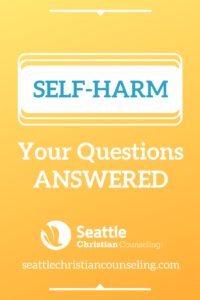Imagine you had a bad day at work. What is the first thing you do when you get home? Do you get yourself a snack and sit down to watch something? Do you call a friend to talk? How do you cope with a hard day or overwhelming emotions?
 Imagine that instead of using your habitual coping mechanism, you reach for a knife and make a shallow incision on your upper arm. You know it won’t kill you, but it hurts, and it bleeds a little.
Imagine that instead of using your habitual coping mechanism, you reach for a knife and make a shallow incision on your upper arm. You know it won’t kill you, but it hurts, and it bleeds a little.
Can you picture doing that as a way to cope with stress, or something else going on in your life?
Unless you’ve struggled with self-injury in the past, you probably can’t understand why someone would do such a thing. Why would you inflict harm to your own body rather than choose a more comforting way to deal with your troubles?
Self-harm both causes pain and relieves pain. The physical pain releases “feel good” hormones, providing an outlet and a distraction from emotional pain. This temporary release can become addictive.
Let’s think about the case of a baby or young toddler who bangs his or her head against something when frustrated. This behavior can be normal in toddlers, but developmentally it should disappear by 3 or 4 years old. If it doesn’t, parents should not hesitate to speak to the child’s pediatrician.
Sometimes, young children or adolescents openly scratch themselves while angry. If done habitually, they may associate self-harm with well-deserved self-punishment, or a way to feel better, or both.
Self-injury is a complex issue with no easy solutions. It’s impossible to provide quick and easy answers as to why a child or teen would do this to themselves. However, we do understand some of the possible motives and symptoms of self-harm, which can often become increasingly hidden the older a child becomes.
It’s very important to be aware of the signs of self-harm so you can protect your child and help them find healthier coping mechanisms and professional help if needed.
Self-Injury in Real Life: Story #1
Isabella is one child who exhibited head-banging as a baby. Her mother would try to stop her, but it wasn’t always possible. Both parents were very confused since they had never seen this behavior in Isabella’s older sister. Isabella’s head-banging lasted into her preteen years.
Eventually, Isabella started working out regularly as a way to destress. Her mom believed she was making progress, but one day she went into her daughter’s room and was stunned to see dozens of knife marks in the headboard above her bed.
Isabella’s mother decided not to confront her daughter directly, but to keep a close watch on her behavior. Over time, the destructive behavior mostly stopped, and Isabella graduated and went to college. Most days, she is calm under stress, but sometimes she still hits herself when she is upset.
When Your Child Self Harms
When self-injury starts in the childhood years, with actions such as head-banging or scratching, overreacting can make things worse.
If self-harm helps the child get attention, they might resort to it more frequently. Conversely, an overreaction might frighten them.
A calm and non-judgmental response can have a soothing effect. Over time, encourage your child to express her thoughts and feelings. Make yourself available for conversations. Validate her feelings even when you don’t agree with them, and take her problems seriously. Provide positive attention and reinforcement whenever possible. Let your child know she is loved unconditionally.
 If your child is open to it, you can help her work to develop more positive coping mechanisms when she is struggling and provide her with the opportunity to work on her communication and social skills.
If your child is open to it, you can help her work to develop more positive coping mechanisms when she is struggling and provide her with the opportunity to work on her communication and social skills.
If your child is willing to talk with you, she might have a difficult time articulating her motive for self-harm and the emotions beneath it. Sometimes she’s not even aware of the underlying reasons for what she’s doing.
If that is the case, therapy might be the best option. With the help of a qualified therapist, a child or teenager who is struggling with self-harm can begin to uncover the layers underneath their actions, which is the first step to finding freedom.
As discussed above, the act of self-injury can become associated with the release of dopamine, a feel-good hormone, in the body. This feeling is fleeting and is quickly followed by guilt, shame, or other negative emotions. Eventually, self-injury can become a cycle. It provides relief from negative emotions, then it fuels more negative emotions, creating a need for another release.
In her book Bodily Harm, Karen Contero writes about how self-harm has become more prevalent in younger and younger children: “Self-harm typically starts at about age 14. But in recent years, we’ve been seeing kids as young as 11 or 12. As more and more kids become aware of it, more kids are trying it.”
She also notes that the behavior often continues into adulthood, even as late as a person’s thirties: “People keep doing it for years and years, and don’t really know how to quit.”
Acknowledging the addictive nature of self-injury is key to taking the first step toward change.

Self-Injury in Real Life: Story #2
As a young child, Logan would bite the inside of his cheek when he got upset. He found this made him feel calmer and less like yelling. But more and more things began to stress him out the older he got. By the time he was a teenager, he resented what he felt was unfair treatment from parents or teachers, arguments with siblings, and being bullied.
Logan felt sad a lot and didn’t realize he was actually depressed. He thought this was just life. When he tried to talk about it to someone, he couldn’t get through, so he just continued his old habit of biting his cheeks, enjoying the temporary relief from his emotional pain.
Eventually, the behavior escalated and he began to scratch himself. He didn’t feel accepted at home. At school, he tried to belong by acting like the teacher’s pet and getting good grades.
In health class every year, students were taught about self-injury. The information piqued Logan’s interest. He fantasized about self-harm until one day, he began pricking himself with a pin until he bled. Eventually, he switched to razor blades.
Once started college, Logan felt free but also afraid. He put pressure on himself to get excellent grades. Cutting helped him escape his depression and release his anxiety, if only for a little while.
Depression and self-harm are complex issues with no easy solutions. Positive thinking can’t cure depression, but healthy coping mechanisms are crucial for overcoming self-harm behaviors.
Logan struggled in his friendships and his relationship with his girlfriend, and cutting didn’t solve those problems. Once he and his girlfriend broke up, the cutting escalated even more.
It’s not as if he always reveled in this behavior, though. He felt ashamed and guilty, and he wanted to hide it from everyone. But at the same time, he knew he couldn’t stop on his own. He went to therapy to figure out his triggers and get support for stopping self-injury.
 Today he allows himself to cry. He speaks about why he is sad. He might find himself biting his cheek at times, but he no longer cuts himself.
Today he allows himself to cry. He speaks about why he is sad. He might find himself biting his cheek at times, but he no longer cuts himself.
In therapy, Logan learned that it’s okay to cry and acknowledge his sadness. He was able to completely stop cutting himself. He still has to work on his self-esteem and social skills, but now when he feels overwhelmed and depressed, he knows not to keep everything inside.
Figuring out his triggers helped more than anything else. He avoids them if possible, but if not, he looks for ways to express his feelings in a healthy. He’s identified safe people in his life to whom he can go when he needs to share what’s going on with him.
Forms of Self-Injury
Self-harm almost always takes place behind closed doors, in a specific, ritualized way that often leaves wounds in a pattern.
Examples of self-harm include:
- Hair pulling
- Scratching oneself
- Hitting or punching oneself
- Burning the skin, using a lit or hot object
- Cutting the skin (70-90% of self-harm is cutting)
- Opening wounds
- Piercing or puncturing the skin
Why Self-Harm?
Here are some of the most common reasons for this complex behavior issue:
- To relieve boredom
- It makes them feel better; it seems to release mental anguish
- It becomes a calming ritual
- It can remove all sense of emotion; it’s numbing
- It is addictive
- It is empowering
- To fit in (especially within certain teenage subcultures)
- To punish themselves
- To act out emotions they cannot verbalize
- They feel empty inside
- They feel lonely, misunderstood or fearful
- They hate or loathe themselves; they feel worthless
- They do not know how to regulate or understand emotions
- They feel panic or anger
- It allows them to feel—something, anything at all
 There are several sites online including YouTube where the glorification of cutting is encouraged. The gullibility of our youth makes such sites enticing. They share stories and show each other their scars. They write poetry making the act of cutting sensual and cool. Some claim that writing about it prevents them from doing it.
There are several sites online including YouTube where the glorification of cutting is encouraged. The gullibility of our youth makes such sites enticing. They share stories and show each other their scars. They write poetry making the act of cutting sensual and cool. Some claim that writing about it prevents them from doing it.
Social media has allowed the promotion of self-harm among teens. Adolescents are gullible and sensitive to the power of suggestion. They may share stories of self-harm online or show pictures of their scars. They write poetry, making cutting seem intriguing and sensual.
While some voices in this space claim that writing about self-harm prevents them from acting on their urges, the net result is still a glorification of self-mutilation. Someone who glorifies hurting themselves is not in a healthy state of mind, to say the least. It’s important for parents, teachers, and mental health professionals to be aware of this subculture and its potential influence on young people.
How Common is Self-Injury?
Although self-harm has become a more well-known issue and it can pervasive at times, it’s actually quite rare in adults, only 4% of whom have ever engaged in it. In teens, however, self-harm is an issue for 17-35% of them. They usually “grow out of it,” but many would benefit from professional help to develop resilience and emotional coping skills.
If an adult is still struggling with self-harm, they will have to be the one to initiate change and get help for developing new skills to replace this destructive practice.
Risk Factors for Self-Injury
- Age. As discussed above, adolescents are overwhelmingly the most likely age group to self-harm.
- Peer influence. If a person has friends who self-harm, the likelihood that they themselves will engage in the behavior goes up.
- Relationship issues. A person’s family or social environment can affect their ability to cope. Someone who is questioning their sexuality or is isolated socially can be particularly vulnerable.
- Mental health issues. Although it is a generalization, it’s safe to say that many people who self-harm are extremely critical of themselves and are not effective problem-solvers.
- Substance abuse. Use of alcohol or drugs increases the likelihood of self-harm in someone who is already predisposed to it.
Diagnosing Self-Harm
Unlike some other mental health issues, someone who is hurting him or herself has an obvious struggle going on inside. Whether they also have a concurrent related mental illness can only be determined by a mental health professional.
Sometimes, self-harm is a symptom of an illness like schizophrenia, anxiety, depression, etc. When making a diagnosis, scab picking, body piercing, and excessive tattooing are not part of the official criteria, but they are often present in the behavior of someone who injures themselves.
Self-Injury and Suicide
Although it may seem surprising, the truth is that most self-harm is not directly correlated to suicide. But on the other hand, people who self-harm are frequently severely depressed and may eventually become suicidal.
Cutting is a risky activity. As the behavior escalates, the person may accidentally cut themselves too deep. Or the addictive cycle of injury and guilt becomes too great to bear, and they feel there’s no way out other than ending their life.
Suicidal thoughts, ideations, or plans require immediate help. Call the National Suicide Prevention Lifeline at 1-800-273-8255.
Complications
Self-harm wreaks havoc in a person’s life both physically and emotionally. Shame and guilt often increase in proportion to the self-destructive behavior. Sometimes cuts or wounds become infected, and they often leave permanent scars.
If you suspect someone you know is engaging in self-harm, don’t hesitate to reach out for help in knowing how to talk to them about it. A qualified Christian counselor can provide support on the journey of healing from self-harm behaviors.
Photos:
“Pink Orange Flower”, Courtesy of Saffu, Unsplash.com; CC0 License; “Skateboarder”, Courtesy of Ryan McGuire, Pixabay.com, CC0 License; “Alone,” courtesy of PublicDomainPictures, pixabay.com, CC0 License; “Self Harm”, Courtesy of Emily_WillisPHotography, Pixabay.com, CC0 License
-
Kate Motaung: Curator
Kate Motaung is the Senior Writer, Editor, and Content Manager for a multi-state company. She is the author of several books including Letters to Grief, 101 Prayers for Comfort in Difficult Times, and A Place to Land: A Story of Longing and Belonging...





